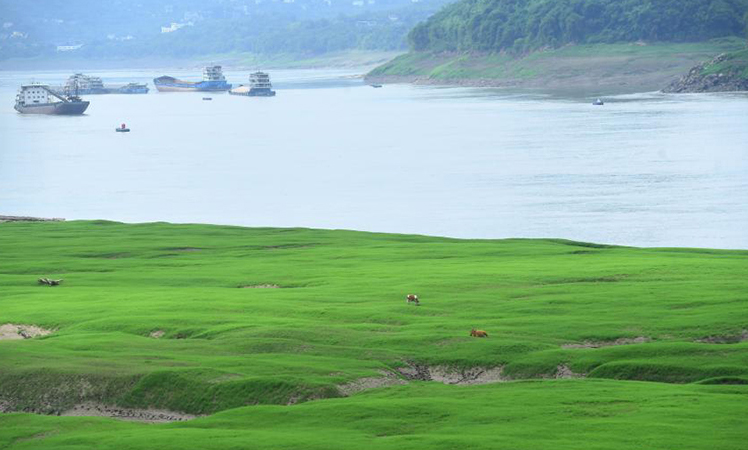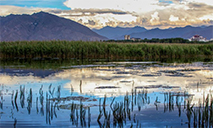Critical U.S. West water supply on verge of failing 40 million Americans
DENVER, the United States, June 20 (Xinhua) -- The eyes of some 40 million Americans in seven states are riveted on emergency efforts to save the Colorado River from drying up, as officials say dropping water levels at two key reservoirs show time will run out in less than 24 months.
Due to megadrought gripping the western United States, the water levels of Lake Mead, the nation's largest reservoir formed by the Hoover Dam on the Colorado River, have dropped to a historic low, as well as Lake Powell, another artificial reservoir on the river and the second largest of the nation.
As of Monday, Lake Mead's level is at 1,044.39 feet MSL (mean sea level), 184.61 feet below full pool of 1,229.00 feet MSL. And Lake Powell is at 3537.18 feet MSL, 162.82 feet below full pool.
"We have urgent needs to act now," Tanya Trujillo, the Interior Department's assistant secretary for water and science, said in a speech last week, of the 1,450-mile waterway that runs from Colorado's Rocky Mountains to Mexico's Sea of Cortez, and supplies water to America's drought-stricken Southwest, 30 federally recognized tribes and Mexico.
"After more than 22 years of drought compounded by warmer temperatures with climate change, Lake Mead and Lake Powell have declined to their lowest levels since they were filled," Planet News Post reported Monday. "The two reservoirs now sit nearly three-fourths empty, at just 28 percent of full capacity."
Lake Powell, on the Utah-Arizona border, is forecast to decline more than 30 feet by next March, putting the water level about 16 feet from the point at which its Glen Canyon Dam, built in 1966, would no longer generate electricity, according to Planet News, adding that "absent large shifts in water use, the reservoirs are expected to continue dropping over the next two years."
WATER USE SHIFT
"We need to be taking action in all states, in all sectors, and in all available ways," Trujillo told a conference at the University of Colorado in Boulder last Thursday via Zoom from Washington, D.C. At Capitol Hill, lawmakers were shocked by testimony from Trujillo and Bureau of Reclamation Commissioner Camille Touton last week after giving dire predictions and Draconian solutions to curb the pending disaster.
"The Colorado River Basin faces greater risks than any other time in our modern history," Trujillo said. "There is much more work to be done in the basin because the conditions continue to worsen and deeper shortages are projected," Trujillo said. "We need to do more than we've ever done before."
Touton told U.S. senators last week at a hearing on Western drought that "states in the Colorado River Basin have 60 days to create an emergency plan to stop using between 2 and 4 million acre-feet of water in the next year," or the agency will use its emergency authority to mandate the reductions.
"I kind of blanched," said John Fleck. "(Two to 4 million acre-feet) is a stunning amount of water," he told Colorado Public Radio (CPR) on Friday.
Fleck, a water policy professor at the University of New Mexico, told the Boulder conference that Touton's directive, "combined with the 'threat' of federal action if the states don't act, creates an extraordinary challenge for water managers and users in the Colorado River Basin."
In comparison, the state of Arizona is allowed to use 2.8 million acre-feet of Colorado River water each year, Planet News said Monday, and that California, Arizona and Nevada used a total of about 7 million acre-feet of Colorado River water last year.
By early 2024, projections show water levels in Lake Powell could drop too low for hydropower turbines to operate and generate electricity, according to bureau hydrologic engineer James Prairie, who presented the Boulder conference with an updated forecast of expected flows into Lakes Powell and Mead over the next few years.
"The challenges we are seeing today are unlike anything we have seen in our history," Touton said at the hearing. She said hotter temperatures driven by climate change have led to less water reaching Lake Powell and Lake Mead.
The surface of Lake Mead was forecast to drop more than 26 feet by July 2023, Planet News said, noting that if "Lake Mead were to keep dropping, the level would eventually approach a danger zone at 895 feet, below which water would no longer pass through Hoover Dam to supply California, Arizona and Mexico - a level known as 'dead pool.'"
In an emergency move earlier this month, the federal government held back water from Lake Powell. Days before, Las Vegas turned on a low-level pumping station that will deliver water from fast-drying Lake Mead even if the Hoover Dam fails.
State officials and managers of water agencies have yet to determine how they could accomplish such large reductions in water use, CPR noted, and that "finding ways of achieving the cutbacks will be the focus of negotiations in the coming weeks between representatives of the seven states and the Biden administration."
Last month, the Interior Department intervened to protect the water level of Lake Powell by announcing a plan to release 500,000 acre-feet of water from Flaming Gorge Reservoir upstream on the Colorado, and leave an additional 480,000 acre-feet in Lake Powell, by reducing the quantity released from Glen Canyon Dam.
Trujillo said the measures aimed to guard Glen Canyon Dam's ability to generate hydropower, "keep water supplies flowing to nearby communities and protect infrastructure at the dam."
She said in a recent letter to state officials that if Lake Powell were to drop below its minimum level for producing power, the dam's facilities would face "unprecedented operational reliability challenges."
Photos
Related Stories
- Assange's case shows hypocritical U.S., British "press freedom": spokesperson
- Multiple people, including police officer, shot in Washington, D.C.
- Multiple people injured as shooting erupted in U.S. capital
- Iran says U.S. approach to nuke talks "unconstructive"
- Domestic dysfunction behind falling U.S.: The Atlantic
Copyright © 2022 People's Daily Online. All Rights Reserved.









